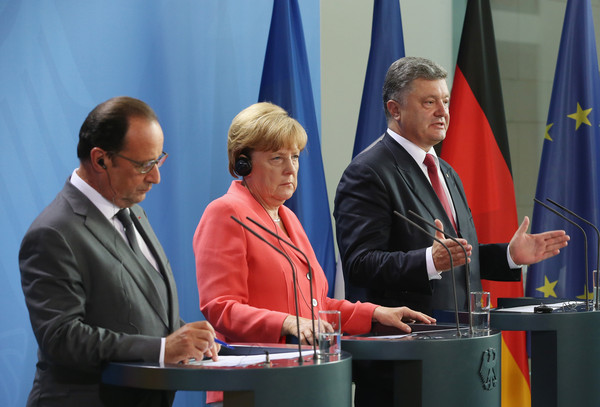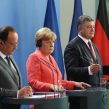
Action Plan to End War in Ukraine Charted at Berlin Meeting (Part One)
Publication: Eurasia Daily Monitor Volume: 12 Issue: 158
By:

An overall consensus, in broad outline, seems to have taken shape among the main European players, pre-eminently Moscow and Berlin, to accelerate a solution to the conflict “in” Ukraine by the end of this year, on Russia’s terms. German Chancellor Angela Merkel hosted a meeting in Berlin on August 24, in an unprecedented “Normandy minus Russia” format, though in basic consensus with Moscow (see EDM, September 2).
Merkel, Ukrainian President Petro Poroshenko, and French President François Hollande (three of the four Normandy parties) have set out a sequence of steps to settle this conflict on conditions acceptable to Moscow. They aim to complete the main work at a high tempo until December 31, the deadline imposed by the Minsk armistice
According to German and French readouts and follow-up actions, the Berlin meeting has set out the sequence of steps toward that end.
1.) Ceasefire: The participants in the August 24 meeting appealed for a full, verifiable ceasefire to be in place by September 1. Ukraine had all along been calling for an immediate and effective ceasefire; with particular urgency during August, when it faced multiple attacks along the demarcation line (see EDM, August 13). The August 24 appeal from Berlin notwithstanding, another round of Russian/proxy attacks followed on August 26–28, killing 11 and injuring 26 Ukrainian soldiers (President.gov.ua, August 27–29). This seemed designed to be a demonstration effect on Kyiv, ahead of the Verkhovna Rada’s (Ukrainian national parliament) August 31 vote on the constitutional status of the Russian-controlled territory in Ukraine’s east. Apparently satisfied with the vote’s outcome, Russian and proxy forces have declared a complete ceasefire as of 00:00 hours, on September 1, which is holding for now (Interfax, September 1, 2).
2.) Pullback of light artillery and tanks: The proposed pullback would create a “buffer zone” to a depth of 15 kilometers on either side of the demarcation line. This does not form a part of the Minsk ceasefire (February 12). It is, instead, a more recent innovation, designed to mitigate somewhat that ceasefire’s ineffectiveness (see EDM, August 14). The August 31 meeting in Berlin, however, could not advance this proposal, since the Organization for Security and Cooperation in Europe’s (OSCE) Special Monitoring Mission (SMM) is prevented from verifying pullbacks in the Russian-controlled territory.
Furthermore, Moscow wants Kyiv to sign the “buffer zone” agreement with Donetsk and Luhansk at senior levels. This would exonerate Russia of its responsibility as an active belligerent, would instead portray the war as internal to Ukraine, and could legitimize not simply the Donetsk and Luhansk “people’s republics” (“DPR-LPR”) as such, but their military organizations also. In practical terms, the “buffer zone,” or indeed the Minsk ceasefire, could only work if the OSCE would monitor the Ukrainian side of the Ukraine-Russia border. Russian and Donetsk-Luhansk forces, however, control a 400-kilometer section of that border from what is legally the Ukrainian side, and do not allow the OSCE to operate along that section. This matter will certainly not be resolved by December.
3.) Halting Russian/proxy harassment of OSCE’s monitoring mission: According to Chancellor Merkel at this meeting, “the OSCE’s ability to operate freely is the Alpha and Omega of sustaining the armistice.” However, Merkel lamented, the mission’s monitors are physically threatened, their movements and access restricted, and the mission’s unmanned aerial vehicles—“which we have so painstakingly supplied”—are being jammed (Bundeskanzlerin.de, August 24). The Chancellor’s readout did not name the perpetrators, although the OSCE’s reports can no longer avoid pointing at Russia’s proxies (Osce.org, July and August 2015). Merkel’s remarks amount to an admission that Ukraine cannot have a reliable ceasefire unless it accepts Russia’s terms on a political settlement of the conflict. Russia expects further decisions in the weeks ahead on the constitutional status of Donetsk-Luhansk and the holding of “elections” there. In that case, Moscow will itself be interested in a show of constructive cooperation with the OSCE for the duration of elections (see below).
4.) Status of the Russian-controlled territory in Donetsk-Luhansk: Merkel and Hollande praised Poroshenko’s “great efforts” to enshrine that territory’s self-administration in an amendment to Ukraine’s constitution. “It is not easy,” they conceded, “to muster a majority for passage of this act in the Ukrainian parliament.” Undoubtedly, they asked Poroshenko to guarantee a majority in the Verkhovna Rada’s August 31 vote; which he went on to deliver. Nevertheless, Merkel’s readout of the meeting hinted at a deeper problem: “there are differences with Russia on this matter; it is imperative to overcome those differences” (Bundeskanzlerin.de, Elysee.fr, August 24).
Indeed, on August 20, Berlin had hosted a meeting of legal experts from all four “Normandy” countries to discuss the Ukrainian constitutional amendment, as well as “elections” to be held in the Russian-controlled territory. In that August 20 meeting, the Russians quoted the Minsk armistice chapter and verse. It states that Kyiv must negotiate the constitutional amendment and the election modalities with Donetsk-Luhansk, seeking “mutually acceptable solutions,” instead of Kyiv legislating solutions “unilaterally.”




